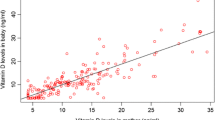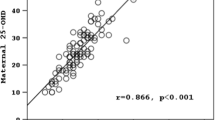Abstract
Aim
To assess the prevalence of vitamin D deficiency in burka-clad pregnant women and to study feto-maternal outcome in these women.
Methods
200 pregnant burka-clad women of 18–40-year age group irrespective of the period of gestation were recruited from the ANC OPD/ward of Kasturba hospital, and their vitamin D levels were estimated. Patients were categorized into vitamin D deficient, vitamin D inadequate, and vitamin D adequate according to The Endocrine Society Guidelines. The association of vitamin D deficiency with dietary/environmental factors was taken note of. Associations with preeclampsia, gestational diabetes mellitus (GDM), low birth weight (LBW), prematurity, APGAR score, and NICU admission were also studied.
Results
78 patients (39.0 %) were vitamin D inadequate; 75 patients (37.5 %) were vitamin D deficient; and 47(23.5 %) were vitamin D adequate. Mean value of vitamin D level was 23.25 ng/ml ± 18.49 (SD). Fifteen patients (7.5 %) developed preeclampsia, and all 15 were vitamin D deficient; 13 (6.5 %) developed GDM; and only 5 (2.5 %) of them were vitamin D deficient. 19 patients (9.5 %) delivered LBW babies; mothers of 15 (7.5 %) of them were vitamin D deficient. 12 patients (6.0 %) delivered premature babies, and mothers of 4 (2 %) were vitamin D deficient; 12 babies had APGAR score <7 at 5 min; mothers of 4 (2.0 %) were vitamin D deficient. Babies of 12 patients (6 %) were admitted in NICU, and of these 12 babies, mothers of 5 (2.5 %) were vitamin D deficient.
Conclusion
The prevalence of vitamin D deficiency was high among burka-clad pregnant women, and it is associated with adverse maternal and fetal outcomes. Routine screening of vitamin D levels is recommended in burka-clad women to improve the feto-maternal outcome.



Similar content being viewed by others
References
Holick MF, Chen TC. Vitamin D deficiency: a worldwide problem with health consequences. Am J Clin Nutr. 2008;87:1080S–6S.
Wagner CL, Taylor SN, Dawodu A, et al. Vitamin D and its role in pregnancy in attaining optimal health of mother and fetus. Nutrients. 2012;4:208–30.
Leffelaar ER, Vrijkotte TGM, Eijsden MV. Maternal early pregnancy vitamin D status in relation to fetal and neonatal growth: results of the multi-ethnic Amsterdam born children and their development cohort. Br J Nutr. 2010;104:108–17.
Marwaha RK, Tandon N, Chopra S, et al. Vitamin D status in pregnant Indian women across trimesters and different seasons and its correlation with neonatal serum 25-hydroxyvitamin D levels. Br J Nutr. 2011;106:1383–9.
Aghajafari F, Nagulesapillai T, Ronksley PE, et al. Association between maternal serum25-hydroxyvitamin D level and pregnancy and neonatal outcomes: systematic review and meta-analysis of observational studies. Br Med J. 2013;346:f1169.
Baker AM, Haeri S, Camargo CA, et al. A nested case control study of midgestation vitamin D deficiency and risk of severe preeclampsia. J Clin Endocrinol Metab. 2010;95(11):5105–9.
Mannion CA, Donald KG, Koski KG. Association of low intake of milk and vitamin D during pregnancy with decreased birth weight. Can Med Assoc J. 2006;174(9):1273–7.
Dror DK, Allen LH. Vitamin D inadequacy in pregnancy: biology, outcomes, and interventions. Nutr Rev. 2010;68(8):465–77.
Bodnar LM, Catov JM, Simhan HN, et al. Maternal vitamin D deficiency increases the risk of preeclampsia. J Clin Endocrinol Metab. 2007;92(9):3517–22.
Zhu T, Liu TG, Ge X, et al. High prevalence of maternal vitamin D deficiency in preterm births in northeast china, Shenyang. Int J Clin Exp Pathol. 2015;8(2):1459–65.
Author information
Authors and Affiliations
Corresponding author
Ethics declarations
Conflict of interest
None.
Ethical approval
This study was approved by institutional ethical committee.
Additional information
Sangita Nangia Ajmani is Senior Consultant, Unit Head; Mohini Paul is Senior Specialist, Poonam Chauhan, Postgraduate Student; Namrta Yadav is Postgraduate Student in the Kasturba Hospital, Daryaganj, New Delhi, India; A. K. Ajmani is Senior Consultant in the Department of Endocrinology, B L K Hospital, New Delhi, India.
Rights and permissions
About this article
Cite this article
Ajmani, S.N., Paul, M., Chauhan, P. et al. Prevalence of Vitamin D Deficiency in Burka-clad Pregnant Women in a 450-Bedded Maternity Hospital of Delhi. J Obstet Gynecol India 66 (Suppl 1), 67–71 (2016). https://doi.org/10.1007/s13224-015-0764-z
Received:
Accepted:
Published:
Issue Date:
DOI: https://doi.org/10.1007/s13224-015-0764-z




